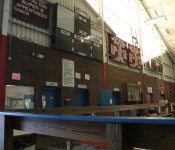Bursting Enrollment Makes Modular Classrooms Likely at Belmont Schools by 2016
Photo: An example of modular classrooms in Needham, Massachusetts.
In the past two years, Belmont town and school officials have used the idiom that the school district has been “bursting at the seams” with the rapid increase in student enrollment – 330 more students – since 2009.
Now that figurative phrase is becoming literally true as the number of pupils continue rocketing upward will likely require the district to begin using modular classrooms – single-story prefabricated buildings most notably used in Belmont to house Wellington Elementary students as the new school was being built – to house the surge of children, according to Belmont Superintendent John Phelan.
Phelan made the observation at two recent meeting in January when the executive summary report of the Belmont Financial Task Force was presented to the public and the Belmont Board of Selectmen.
It doesn’t require a lengthy report to realize that with any increase in enrollment, “the need for increased classroom space is inevitable,” said Phelan.
The first steps to quantify the impact on school buildings began more than a year ago under former Superintendent Dr. Thomas Kingston who established a Space Task Force. One of the first actions taken was hiring a local architectural firm to project the district’s building requirements with the space it had and the estimated number of students coming into the system.
The study concluded for Belmont to keep within its appropriate class-size range, the elementary schools will require an additional class from kindergarten through 4th grade.
“This would result in the need for modular classrooms … by September 2016” for the elementary schools, said Phelan.
The report bluntly stated the Chenery Middle School “does not have enough space to support the current level of student enrollment” and won’t be able to fit the large classes funneling from the four elementary schools in the next five years.
The solution “will result in the need for modular classrooms” by the beginning of the 2016-17 school year.
Nor is the situation at the aging Belmont High School any better. The school is currently “out of space,” said the report, with 31 rooms shared by two teachers and four rooms by three teachers.
With the demand for additional class offerings and “the wave” of enrollment increases coming each year,” the need for space at the High School is becoming critical,” said Phelan.
The “wave” Phelan talked about is evident comparing the 260 students who graduated in 2014 with the 354 students who entered Kindergarten that same year. And those numbers are not seen dropping as “[h]istorical enrollment trends indicate there is little if any, net loss of enrollment over the grade spans.”
In its long-term plan to meet the sky-high enrollment issues facing Belmont, the school district will request hiring an additional 20 teachers over three years beginning in the 2015-16 school year, all dependent on the passage of a $4.5 million Proposition 2 1/2 override sometime in the spring.
A major new initiative by Phelan will be to target eight of the new teachers to reduce the chronic issue of student either sitting in large study halls in the middle school and having idle time at the high school known as “frees.”
The Board of Selectmen has yet to approve or set a date for the override as of Feb. 11.
Even with a successful override vote, space will continue to be a glaring handicap for the schools.
“If you want to increase the number of teachers at the middle or high school to reduce the amount of unstructured, non-educational time … the district will struggle with the ability to do so, without adding temporary space or building more permanent space,” warned Phelan.
Less Than a Week to Turn In Town Meeting, Town Wide Nomination Papers
The good news, said Belmont Town Clerk Ellen Cushman, is the number of residents who took out nomination papers will result in competitive races in nearly all of Belmont’s eight precincts.
The bad news, see added, is that many potential candidates have yet to turn in those papers with the signature of 25 Belmontians to her.
“They’ve taken them out, and now I’m waiting for them to bring them back,” said Cushman today, Feb. 11.
And the deadline for the papers to be in and certified by Cushman is looming quite large.
“They only have six day, until Feb. 17 at 5 p.m. And when the bell rings, they’ll lose their chance,” said Cushman, pointing to a call bell next to the old-style time stamp machine on the Office’s front desk.
Belmont’s eight precincts will be electing 12 Town Meeting Members in addition to any partial-term seats. Cushman opened a folder for one of the precincts and showed the sign-out sheet with several names of residents who took out papers. Only one had been turned in.
People should not wait until the last minute to return nomination papers for either Town Meeting or for those with intentions of running for town-wide office, said Cushman, reminding residents her and all town offices will be closed for the President’s Day Holiday on Monday, Feb. 16.
Water Main Break Halts Traffic on Brighton/Blanchard, Repair by 4 PM
A major water main broke around 9 a.m., Tuesday, Feb. 10, on the north side of Brighton Street at the commuter rail tracks, causing the closure of an important cross town thoroughfare.
Belmont Police detoured traffic off of Blanchard Road from Concord Avenue to the commuter tracks and Brighton Street to Vale Road and the tracks to allow Department of Public Work crews to remove and repair the pipe that spewed water onto the roadway for a short time.
“We found a major crack in the pipe so it had to be removed and a new section cut at the DPW yard,” said Mark Mancuso, operations manager of the DPW’s Water Division.
There was some concern from the MBTA the water from the leak could freeze onto the commuter rail tracks, said Mancuso. That problem did not materialize, he added.
Mancuso said the pipe should be replaced and the road reopened by 4 p.m.
School Closed Tuesday; Full Parking Ban Ends 7AM Tuesday But Parking Limited to Odd Side
Once again, the Belmont Public Schools will be closed on Tuesday, Feb. 10 due to the nearly 20 inches of snow that fell on Monday.
Also on Tuesday, the full Snow Emergency Parking Ban will be lifted at 7 a.m. Until that time, a full parking ban will be in effect, including on-street parking as well as municipal and school parking lots. Violators will be ticketed and towed.
After 7 a.m., the partial Snow Emergency Parking Rules will be in effect which limits parking on most streets to the odd-numbered side of the street.
Trash will be picked up on normal schedule
While the Beech Street Center will remain closed on Tuesday, Belmont’s two libraries, the Belmont Public and the Benton, will be open for regular hours.
Belmont Schools Closed Monday, Emergency Parking Ban In Effect 6 PM Sunday
The instructions on shampoo bottles once had a familiar description: “Lather, rinse, repeat” which, if taken literally, would result in an endless loop of repeating the same steps.
In the past two weeks, it has appeared the Belmont has been in that endless loop as for the third time in two weeks, the town will effectively shut down due to yet another snow storm heading into eastern Massachusetts.
- The Belmont Public Schools will be closed on Monday, Feb. 9, due to the day-long storm that is expected to drop up to a foot of snow on the town.
- In addition, the Belmont Public Library and the Beech Street Center will be closed on Monday.
- Beginning at 6 p.m., Sunday, Feb. 8, the town is declaring a snow emergency during which there will be a parking ban on on-street parking and in the three town municipal and six public school parking lots.
- Trash and recycling pickup will occur on Monday despite the storm.
‘Active’ Bidding for Belmont Center Reconstruction Project
It appears likely that Belmont Center will be quite busy beginning this spring.
Four construction firms have taken out the necessary paper work to bid on the $2.8 million Belmont Center Reconstruction Project since town opened the bidding on Jan. 30.
“This shows there’s interest in the project and that’s good because there will be competitive bidding,” said Andy Rojas, the chair of the Board of Selectmen, who spoke before the Warrant Committee on Wednesday, Feb. 4.
The project, which is the calumniation of five years of planning and debate, is set to improve sidewalks, crosswalks, pavement repairs and add new lighting in the town’s main business hub.
The bidding period will close on Feb. 27 at 10 a.m. The work is expected to begin in March with expected completion on Oct. 31, 2015.
The reconstruction will also allow the town to install a new parking system that includes parking stations along Leonard Street.
The project was approved by a Special Town Meeting in November, using the town’s “free cash” account to fund the work.
While businesses along Leonard Street have been supportive of the project, they are wary that the construction schedule will impact the Belmont Center Business Association’s annual Town Day celebration that takes place in mid-June.
“We will need to discuss this with the town so we can plan for it,” said Gerry Dickhaut of Champions Sporting Goods.
Talks on Possible Private/Public Partnership to Rebuild Skating Rink Underway
Photo: Belmont’s ‘Skip’ Viglirolo Skating Rink.
First, the White Field House. Then, the new Underwood Pool. Next, the town’s skating rink?
After two successful public/private partnerships restored and saved a pair of town/school facilities in the past year, word is spreading that negotiations are underway for a possible collaboration between the town of Belmont and either an individual or a group to renovate the town-owned ‘Skip’ Viglirolo Skating Rink located adjacent to Harris Field at 297 Concord Ave.
“There are talks, but that’s all I know,” said Belmont Town Administrator David Kale after Wednesday’s meeting of the Warrant Committee, adding that he does not know who is the outside party who reached out to Belmont officials.
People in the sports community and town government have echoed Kale’s refrain: someone or a group has shown interest in renovating the rink, the condition of which is, at best, threadbare.
But other than acknowledging there are discussions, those in the know are keeping tight-lipped.
There is little debate the skating rink, owned by the town and run through the Recreation Department, is badly in need of a complete renovation.
Built in 1971 during the height of popularity of the Boston Bruins and their star, Bobby Orr, the nearly 29,000 sq.-ft. rink was originally an open air facility until the early 1980s when it was enclosed. The rink is home to the Belmont High School Marauders Hockey teams and Belmont Youth Hockey. The rink is also available to residents for recreational use.
The unheated rink is known for its steel panel walls with gaping openings that allow the frigid outdoor temperatures to seep inside. While many hockey players say the ice benefits from the blast of cold outdoor air making for improved skating, spectators are forewarned to bundle up before venturing inside. Several years ago, a visitor from Canada told the Belmontonian editor he attended games at outdoor rinks in Calgary which were warmer than the inside of the ‘Skip.’
It is unlikely the required work needed to upgrade the skating rink is on the horizon.
According to a recent study by the Capital Budget Committee, renovating the skating rink will cost an estimated $5 to $6 million. The committee also noted such a repair is not a current priority for the town; a new $20 million police station or a $28 million Department of Public Works Yard are higher on the list of needed capital projects.
For those reasons, a collaboration between the town and outside financing is the best chance for a renovated rink in the near future. In addition, Belmont is coming off two highly successful public/private ventures in 2014. A group of residents led by Frederick Jones contributed $100,000 and hours of sweat equity to extensively renovate the eight-decade old White Memorial Field House before the start of the 2014-15 fall sports season at Belmont High School.
Last fall, Belmont Savings Bank led the effort to raise $400,000 in public money by contributing half of the amount to save the construction of the new Underwood Pool after a low bidder withdrew its bid.
Belmont’s Snow/Ice Removal Budget ‘Burned Through’ in a Fortnight of Storms
When calculating the snow and ice removal budget each year, the town looks at historical data and prices for raw material before determining that final figure.
This winter, the town’s determined it would likely clear about 45-inches of snow as well as sanding and salting the roads for approximately $600,000.
“You make your best estimate and go with it,” said Belmont Town Administrator David Kale last week.
“Some years, $600,000 is OK,” said Kale.
But with any prediction, sometimes you get it right and sometimes the odds get thrown out the window.
In the past two week, Mother Nature decided to throw a wooden shoe into the Belmont budget maker’s forecasting machinery, dumping nearly a season’s worth of snow – a whopping 40 inches – during the fortnight.
With Belmont’s Department of Public Works crews and approximately 40 private contractors worked around the clock attempting to clear the town’s streets and main sidewalks, the dual storms have busted the town’s snow removal budget, as well as making it more difficult for the school district to resolve its river of red ink.
“While we are still receiving bills from our vendors and calculating the costs, it’s likely true we’ve already burned through the $600,000 budgeted for removing snow,” said Kale after the Warrant Committee meeting on Wednesday, Feb. 4.
Fiscal 2015 will mark the second year running the snow and ice budget will end up in the red. Last fiscal year, Belmont spent $709,000 on snow removal, $142,000 over the budgeted amount.
And with still half of winter to come, Kale said the town is likely facing a significant hole to fill in the account by the end of the fiscal year on June 30.
But residents should not fear Belmont roads being left untouched until spring once the snow and ice account spends its final dollar. The annual town budget has a reserve funds account – a sort of rainy day fund – for just these sorts of incidents. The account, which has $400,000, can be tapped through a transfer of funds requiring Town Meeting approval.
While it appears the town will find the money for snow and ice removal, the same reserve account was being eyed by the Belmont School District as it currently sits in a $500,000 hole midway through its fiscal 2015 budget, according to Anne Lougee, the School Committee’s representative to the Warrant Committee.
With costs associated with the rapid increase in enrollment in Belmont schools, including nearly $1 million in added expenditures in the special education line item, the district had been counting on the reserve account to cut the deficit.
Hike in Parking Fees Spark Belmont Business Owners Ire
Photo: Bells & Whistles’ Meghan Aufiero at the community parking lot behind Belmont Center, Tuesday, Feb. 3.
There was a surprise waiting for Meghan Aufiero as she arrived for work at Bells & Whistles, the home furnishings, gifts and accessories store on Leonard Street on a frigid Tuesday morning, Feb. 3.
As she was putting dollar bills into the parking machine, she discovered the daily rate to park in the Belmont Center commuter lot would cost her an extra $2 a day to $5.
“This is a bummer,” the Winchester resident said when she discovered the 75 percent increase in the price of parking in Belmont’s commercial hub.
Aufiero is just one of dozens of employees of small businesses and franchises feeling the impact of the near doubling of the daily parking charge, approved late last year by the Belmont Board of Selectmen at the recommendation of a citizens/town group that spent more than a year determining the parking operation was not paying its way.
The new parking scheme, which went into effect Sunday, Feb. 1, includes the new fee structure and an attempt to monetize the vast number of commuters who have parked on Belmont streets for nothing, or close to it, for decades.
In addition to the hourly and daily fees jumps, the town has created 10 new weekday parking spots along Royal Road adjacent to the MBTA’s commuter rail station at Belmont Center and spaces in the Belmont Center commuter parking lot reserved for commuter pass holders. Those monthly passes are going for $90 a pop, an increase of $30.
The jump in fees, delayed a month at the request of local businesses, has been as welcome as the two snow storms that have hampered businesses in the town’s main commercial area.
“I can’t, and won’t, tell you how angry I am about this,” said a Leonard Street business proprietor.
Owners say the result of the new commuter parking plan is their staffs are left holding the bag, which needs to be filled with quarters to feed the parking machine.
For Belmont Toys owner Deran Muckjian, the increase will be an additional burden on his employees.
“The are now being asked to pay $1,200 or more this year just to come to work,” he said.
For Shelley MacDonald, who travels from Clarendon Road to Belmont Center, the additional cost of parking is making it harder for her to justify coming to work at the town’s only toy store.
“These little businesses don’t make enough to offset the new price for their employees. How can they retain good workers?” MacDonald asked.
Muckjian is not just upset by the added costs to his employees, but whether the increases are justified. Muckjian said his parking costs in towns where he has other stores are considerably less; in Lexington, he pays $250 a year each for two employee passes while Winchester does not charge a nickel for employee parking permits.
“What are the costs to park here? Keep the blacktop repaired? Making sure the parking machine is working?” Muckjian said.
At the very least, said Muckjian, a discount should be provided to the employees with the subsequent decrease in revenue be made up by increasing the fees on commuters.
A monthly pass at the nearby Alewife Station in Cambridge is $7 a day while the parking lot at the Fitchburg/Acton commuter line stop at the Brandeis stop in Waltham is $4 daily.
So far, there has been little communications between owners and the town on resolving the matter.
Champions Sports Goods owner Gerry Dickhaut said he has yet to receive a reply to a Belmont Center Business Association letter on business owners’ concerns. The single-page note, dated Dec. 8, suggests cutting the increase in the daily rate in half, up a $1 to $4 a day, retain the $60 a month pass for employees while jacking up the cost to commuters to $15 a day, which would still be half the cost of parking in downtown Boston.
But the town official who presented the case for the fee hike at a pair of public meetings last month said the increases in daily and monthly rates are past due.
Belmont Town Treasurer Floyd Carman, said rates have been kept steady since January 2009 while the demand for parking spots is outstripping supply.
“Belmont parking is at a premium. We are not like other towns that either has the space for big lots or a lot of industry that can subsidize parking,” said Carman. “Belmont does not have that luxury; We have a limited number of parking spaces. That’s the facts.”
He said the town’s parking advisory group, made up of residents and town officials, made an extensive analysis of the parking rates in many communities, not just neighboring municipalities. The new price structure “is a function of what it takes to run the program and what’s fair.”
Carman said the need for the town to employ three parking enforcement personnel and keeping all the equipment running requires the town to raise about $35,000 a year on fees to make the program pay for itself.
“Believe me, the town is not getting rich on this increase,” said Carman.
As for alternatives and price breaks for employees, Carman said he has not seen any proposals “come across my desk.”
“If the business association comes to me with a proposal, I am ready to talk to them and then presented to the Board of Selectmen,” said Carman.
- «Previous Page
- 1
- …
- 109
- 110
- 111
- 112
- 113
- …
- 127
- Next Page»





